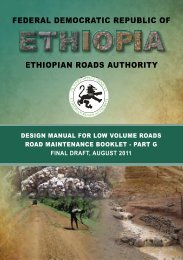Design-Manual-for-Low-Volume-Roads-Part-A
Design-Manual-for-Low-Volume-Roads-Part-A
Design-Manual-for-Low-Volume-Roads-Part-A
Create successful ePaper yourself
Turn your PDF publications into a flip-book with our unique Google optimized e-Paper software.
A - Chapter 1 - 8<br />
Mostly design<br />
engineer<br />
responsibility<br />
Politically supported<br />
Mostly client<br />
responsibility<br />
Environmentally<br />
sustainable<br />
Socially acceptable<br />
Financially sound<br />
Context sensitivity &<br />
sustainability <strong>for</strong> low volume<br />
road provision<br />
Institutionally<br />
possible<br />
Technologically<br />
appropriate<br />
Economically viable<br />
Figure A.1.3: Framework <strong>for</strong> sustainable provision of low volume roads<br />
There is a need to maintain dialogue with political and public stakeholders in order to highlight the<br />
advantages of design approaches and alternative, often unfamiliar, solutions selected <strong>for</strong> low volume<br />
road provision. The language used <strong>for</strong> advocacy should be carefully chosen and should avoid negative<br />
connotations such as “low standard”; “low cost” and “marginal”.<br />
1.6.2 Social acceptance<br />
Provision of low volume rural road networks should be managed in a way that:<br />
• Ensures community participation in planning and decision making;<br />
• Eliminates gender bias and promotes participation by women in the road sector;<br />
• Promotes activities and investment <strong>for</strong> sustainable livelihoods (including Complementary<br />
Interventions shown in <strong>Part</strong> C);<br />
• Promotes road safety in all aspects of low volume road provision.<br />
• Supports cost-effective labour-based and intermediate equipment methods of construction and<br />
maintenance; and<br />
• Minimises resettlement and mitigates unavoidable resettlement through appropriate compensation.<br />
1.6.3 Institutional capacity<br />
Road authorities and clients should:<br />
• Promote institutional, economic and technical understanding in the provision and management of<br />
low volume roads;<br />
• Promote commercial management practices;<br />
• Develop a conducive environment <strong>for</strong> the development of national contractors;<br />
• Ensure that design, construction and maintenance approaches <strong>for</strong> low volume roads are represented<br />
on all tertiary civil engineering training curricula.<br />
1.6.4 Technology choice<br />
Technologies <strong>for</strong> designing, constructing and maintaining low volume roads should:<br />
• Employ appropriate design standards and specifications;<br />
PART A: DESIGN STANDARD APPROACHES

















